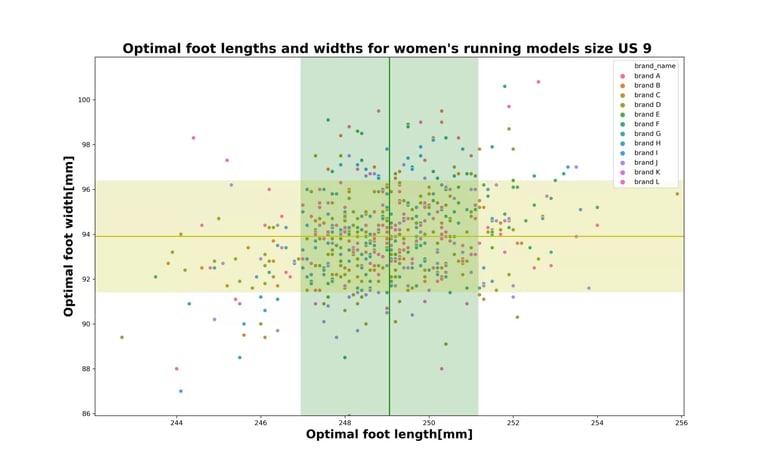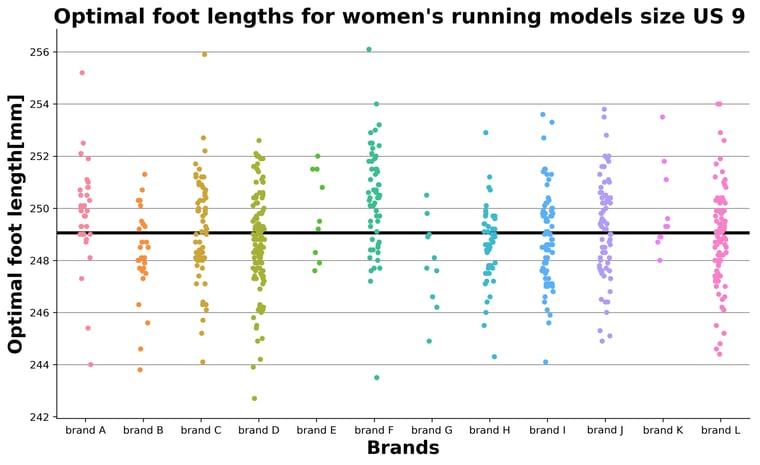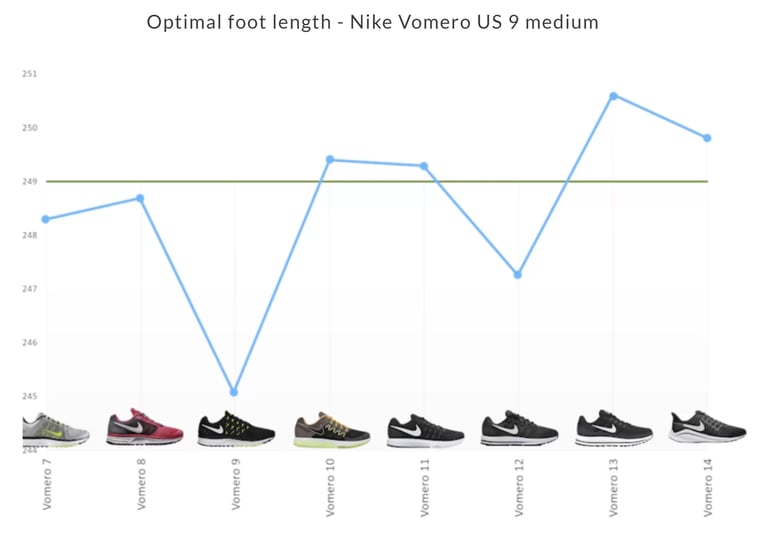The size label in a shoe is a very poor indicator of the actual fit. You’ve probably experienced trying on several styles of the same size that didn’t fit the same. We now have exact data to show the fit variety of shoe models of the same size. In this study, we analyzed the fit of over 600 women’s running models in size US9 medium width.
Measuring the fit of a shoe is a challenging task. In the past, several methods have been used to capture the actual shoe size and fit:
-
Mechanical devices to measure the inside length of shoes. The fit of a shoe depends on many other parameters like ball width and girth, instep girth and height, and many more, therefore, the inside length measurement doesn’t really provide information about the actual shoe fit.
-
Optical 3D scans of the shoe's inside surface. An example of this technology was Shoefitr, which was acquired by Amazon in 2015. The problem with this approach is that it captures the inside surface of an empty shoe, but the internal shoe shape changes significantly with a foot in the shoe. Therefore measuring an empty shoe is not really useful.
-
X-ray and CT scans of shoes. This method has a similar problem as the others because it is really difficult to simulate a foot inside the shoe while performing a scan.
The Science Behind The Problem
At Volumental, we believe that human feet are the most accurate device to measure how a shoe fits. Because of our large database of millions of 3D foot scans matched to purchase data for each scan, we can apply machine learning and AI algorithms to predict the fit of each style of shoe, and then make more accurate recommendations for a specific foot. For example, by having foot scans of many women runners who bought a specific style, like the Nike Vomero 14 in size US9, we can calculate the optimal foot that fits into this shoe.
Using foot scans and purchase data, we compared the fit of 611 running styles from 12 most popular running brands. Results are presented in the following chart:

Each dot in this chart represents one running model. The horizontal position of each dot indicates the length of the optimal foot that fits into that model (models on the left have a shorter optimal foot, models on the right have a longer optimal foot that fits into the shoe). The vertical position of each dot indicates the width of the optimal foot for that model (models at the top have a wider optimal foot, models at the bottom have a more narrow optimal foot). The optimal foot for each model was calculated using hundreds or even thousands of foot scans of shoppers that bought that style in size 9. The vertical and horizontal bars show the range of one US size and width. Shoes located in the overlapping area of both bars fit as a true US9 medium.
So here’s the scary thing - only 63% of all 611 styles we sampled would fit as a true US9 medium. And we wonder why returns are such a problem for retailers, especially when purchased online?
The next chart demonstrates that all the brands are quite similar in terms of size inconsistency:

Again, each dot represents one of the 611 models which are grouped by brands. The vertical location of a dot indicates the length of the optimal foot that fits into that shoe. Models of each brand vary significantly in terms of the optimal foot length. Brand F is very interesting, most shoes run larger than the average, and we can see one style that runs much smaller.
We observed a similar pattern even within models of the same style. In the following chart, we compared optimal foot lengths for Nike Vomero from version 7 to version 14. A large variation between the models is clearly noticeable. Version 9 stands out by running much smaller than the rest.

All these Nike models have the optimal foot lengths in the range between 245mm and 251mm, and according to the Nike size chart, US9 fits feet that are 260mm long. Only two out of 69 Nike models in this study match their online sizing chart.
The Solution
There is no doubt that footwear brands could utilize this data to improve the consistency of shoe sizes. However, shoe size standardization is still a complicated task. If we think of what defines the fit of a shoe, we would probably agree that shoe lasts are very important, and they could be standardized better. But there are many other parameters that influence fit. If you were to try a shoe such as a trainer made from a very elastic upper material, it will fit much larger than a shoe made from leather, even when they are produced from the same shoe last. Because of all the parameters that influence the fit of a shoe, there will always be some variation of fit, even between shoe models of one brand.
So the real solution to the sizing issue is measuring how each shoe fits and providing the information to shoe shoppers directly. Based on all my experience in using different methods to measure the fit of shoes, I’m confident that the method I described above is by far the most accurate and scalable. Big data has proven to be effective in solving hard problems in many domains, and it can definitely solve the footwear sizing issue. Applying machine learning and AI methods on large datasets of foot scans matched to specific footwear purchases provides a new level of size recommendations to in-store sales associates, e-commerce stores, and shoe shoppers.
